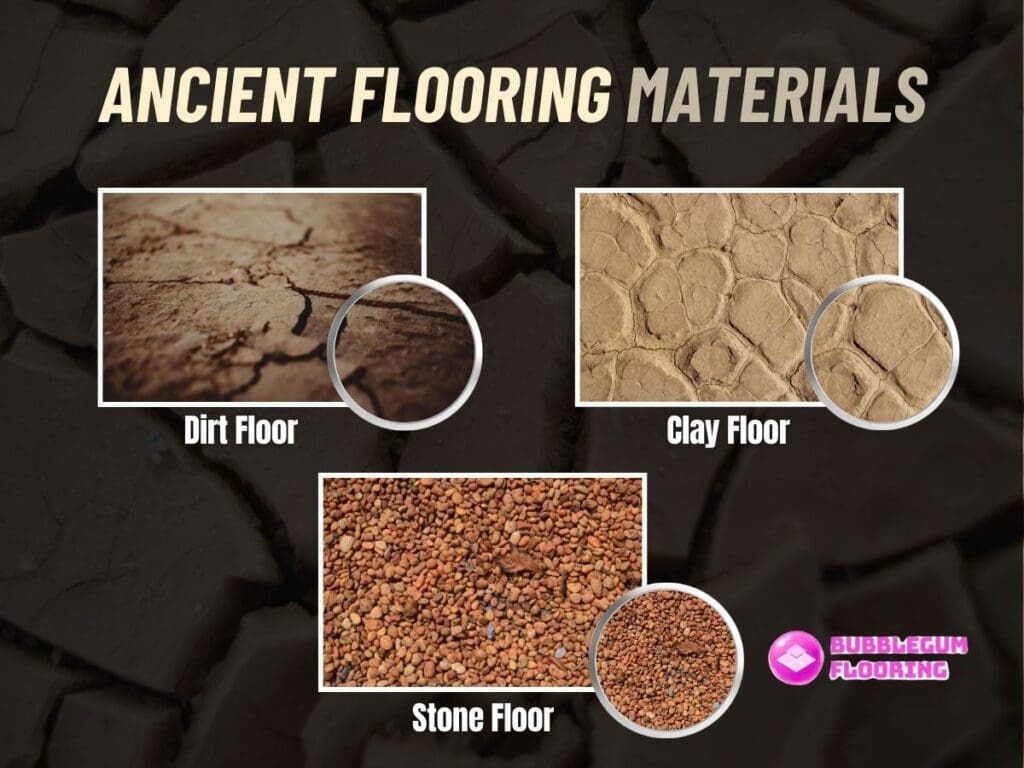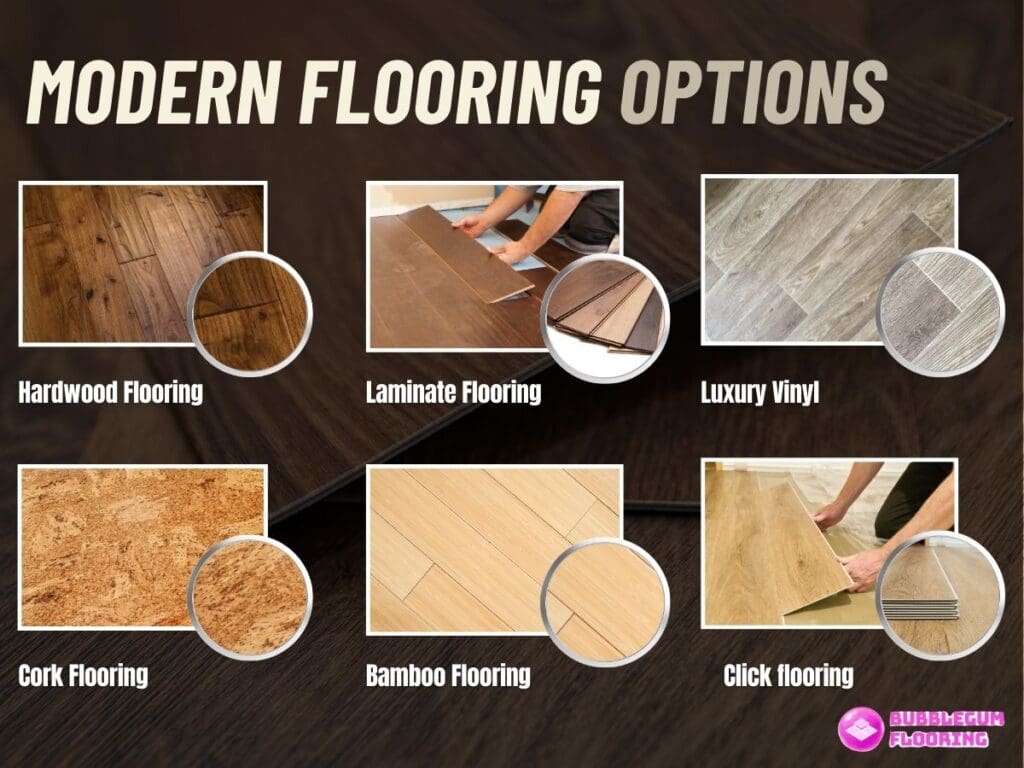The history of flooring reflects humanity’s constant pursuit of functionality, comfort, and beauty. From the natural materials used by ancient civilizations to the intricate parquet patterns of the Renaissance and the synthetic innovations of today, flooring has evolved alongside culture and technology.
Each era brought new materials and styles that catered to changing tastes and needs. In the late 20th and early 21st centuries, flooring trends shifted once more, embracing both natural aesthetics and modern, eco-friendly solutions, offering a diverse range of options for homeowners and designers alike. Let’s look at the evolution of flooring.
Historical Context
Flooring has played a significant role in human history, evolving alongside technology, culture, and aesthetic preferences. From rudimentary natural materials to the development of intricate designs and modern synthetic options, the history of flooring tells the story of human ingenuity and the pursuit of comfort and beauty in living spaces.
Ancient Flooring Materials
In the earliest civilizations, flooring was often a reflection of what materials were readily available in nature. In ancient times, the most basic flooring materials included dirt, clay, and stone. These were practical, long-lasting, and relatively easy to source, fitting the needs of early societies that required functionality above all else.

In Mesopotamia and Egypt, for example, clay was widely used for floors, particularly in homes and common buildings. The Egyptians also made use of limestone and sandstone for more durable and decorative purposes in temples and palaces. These natural stones were often cut and polished to provide smooth, durable surfaces.
The Greeks and Romans, on the other hand, elevated flooring to an art form. In ancient Greece, stone slabs were often used in public buildings and wealthy homes, while the Romans created intricate mosaic floors, combining small pieces of stone, glass, or ceramic to form elaborate patterns. These mosaics were not only practical but also served as a form of expression, showcasing scenes from mythology, nature, and daily life.
Flooring in the Middle Ages
The Middle Ages brought significant changes to flooring, especially among the aristocracy. Wooden floors became increasingly popular, especially in castles and manors where timber was abundant. These floors were often made of rough-hewn planks, and though they provided some insulation, they were far from the polished wooden floors we think of today.

To improve comfort, rushes, straws, and even herbs were strewn across the floor as a form of makeshift carpeting. This practice helped insulate the home and provide a soft surface underfoot, though it was not particularly hygienic.
Religious structures in the Middle Ages often had more durable flooring materials. Stone and tile were frequently used in churches and cathedrals, particularly in areas where the congregation would walk or gather. These materials were both symbolic and functional, reflecting the permanence and sacred nature of these spaces.
Renaissance and Baroque Periods
The Renaissance ushered in a new era of design and craftsmanship, with flooring becoming more of a decorative element in both homes and public spaces. The focus shifted towards aesthetics and intricate detailing, particularly among the wealthy elite.

Introduction of Parquet Flooring
One of the most significant innovations in flooring during the Renaissance was the introduction of parquet. This style of flooring, made from small, geometric pieces of wood arranged in intricate patterns, became immensely popular in France and Italy.
Parquet floors were labor-intensive to create, as each piece of wood was cut, shaped, and arranged by hand. Popular patterns included herringbone, chevron, and basketweave, which added an air of sophistication to palaces and aristocratic homes.
Parquet flooring became particularly associated with the French monarchy, and its use in the Palace of Versailles solidified its status as a luxurious flooring option.
Rise of Carpeting
During the Baroque period, carpeting also saw a rise in popularity, particularly in England. Initially, carpets were used as wall hangings or table coverings, but over time, they began to be used more frequently as floor coverings in homes of the wealthy.
Carpets were handwoven and imported from regions like Persia and Turkey, making them expensive and exclusive. As a result, they were often used as a status symbol, adding warmth and luxury to homes.
The Industrial Revolution
The Industrial Revolution brought sweeping changes to flooring materials and manufacturing processes, revolutionizing the way floors were made and used in both residential and commercial buildings.

Technological Advancements
One of the key advancements in flooring during the 19th century was the development of linoleum. Invented by Frederick Walton in 1860, linoleum was made from a mixture of solidified linseed oil, ground cork dust, and wood flour. It was affordable, durable, and relatively easy to install, making it an appealing choice for homes and commercial spaces alike. Its water-resistant properties also made it ideal for kitchens, hallways, and other high-traffic areas.
By the early 20th century, vinyl flooring entered the market. Made from synthetic materials, vinyl offers even greater durability and moisture resistance than linoleum. It also allowed for a broader range of designs and patterns, as it could be printed with vibrant colors and intricate designs. The mass production of both linoleum and vinyl during this period made them widely accessible to the average consumer, contributing to their popularity in homes and businesses.
Mid-20th Century Trends
By the mid-20th century, flooring trends began to shift. In the 1950s and 1960s, colorful linoleum and vinyl became especially popular, as post-war optimism brought about a renewed interest in bright, bold interior design. Homeowners embraced the variety of patterns and colors available, often using flooring as a way to make a personal statement in their homes.
Around this time, wall-to-wall carpeting also gained traction. Advances in manufacturing allowed for carpets to be made more affordable, and the introduction of synthetic fibers like nylon and polyester further lowered costs while improving durability.
Carpeting became a staple in residential homes, particularly in bedrooms and living rooms, where it provided warmth, comfort, and sound insulation. The availability of wall-to-wall carpeting in various colors and textures allowed homeowners to customize their spaces in ways that had previously been reserved for the wealthy.
Late 20th Century to Early 21st Century
Flooring styles and materials have evolved in response to changes in aesthetic preferences, technological advancements, and environmental concerns. From the return of natural aesthetics in the 1990s to the introduction of cutting-edge synthetic options, flooring continues to reflect cultural shifts while embracing innovation.

Return to Natural Aesthetics
In the 1990s, there was a marked shift towards natural aesthetics in home design, particularly in flooring. This era saw the resurgence of light wood finishes, like oak and maple, which became synonymous with minimalist and modern styles. The popularity of glossy finishes, which gave wood floors a sleek and polished appearance, complemented the bright and open interiors that defined the decade.
Homeowners embraced the clean, natural look of light wood floors as part of a broader movement toward simplicity and natural materials. While carpeting remained popular in bedrooms and living spaces, hardwood floors became the preferred choice for living rooms, kitchens, and dining areas. The introduction of prefinished wood planks also made hardwood flooring easier to install and maintain, further driving its popularity.
Distressed and Reclaimed Materials
By the 2000s, home design trends began to shift again, this time toward a more rustic and organic look. Darker wood floors, such as walnut and mahogany, became increasingly popular. At the same time, homeowners sought out distressed and reclaimed materials that offered a weathered, vintage feel.
This trend was driven, in part, by a growing interest in sustainability and environmental consciousness. Reclaimed wood, sourced from old buildings, barns, or even wine barrels, became a sought-after material for flooring. These materials not only had a unique, rustic charm but also aligned with the desire to reduce waste and repurpose old materials.
The imperfections in reclaimed wood, such as knots, cracks, and color variations, were embraced as part of the aesthetic, offering a sense of character and history to modern homes.
Modern Flooring Options
As we moved into the 21st century, flooring choices expanded dramatically, with new materials and technologies transforming how we think about home design. Today’s homeowners have a wider range of options than ever before, each offering its own benefits in terms of aesthetics, durability, and sustainability.

Diverse Material Choices
Contemporary flooring offers an extensive selection of materials that cater to various design preferences and functional needs. While traditional hardwood remains a popular choice, several new materials have gained traction:
- Hardwood: Still the gold standard for many, hardwood offers a timeless look and long-lasting durability. Available in a wide range of species and finishes, hardwood floors can complement both modern and traditional interiors.
- Laminate: A more affordable alternative to hardwood, laminate flooring mimics the look of wood or stone at a fraction of the cost. It’s made from a compressed fiberboard with a photographic layer that simulates natural materials. Laminate is prized for its durability, making it a popular choice for high-traffic areas.
- Luxury Vinyl: Luxury vinyl tile (LVT) and plank (LVP) have revolutionized synthetic flooring. These materials offer a highly realistic appearance that mimics wood, stone, or tile. Luxury vinyl is waterproof, making it ideal for bathrooms and kitchens, and is softer underfoot than traditional vinyl or tile.
- Bamboo: A rapidly renewable resource, bamboo has emerged as an eco-friendly alternative to hardwood. While technically a grass, bamboo has similar strength and durability to traditional wood floors, and it offers a unique, modern look.
- Cork: Another sustainable option, cork flooring, has gained popularity due to its eco-friendliness and comfort. Cork is soft and quiet and provides insulation, making it an ideal choice for bedrooms and living spaces. It’s also naturally resistant to mold, mildew, and pests, making it a healthy choice for homes.
Technological Innovations
The flooring industry has seen significant technological advancements, particularly in terms of installation methods and material innovations. One of the most notable developments is the rise of DIY-friendly flooring options like click-lock or floating floors. These installation methods allow homeowners to install flooring without glue, nails, or professional assistance. Click flooring, for example, uses interlocking planks that “click” together, making it easy to lay down a new floor in just a few hours.
Technological advancements have also led to the development of more durable and eco-friendly synthetic materials. For example, modern laminate and luxury vinyl are highly resistant to water, stains, and scratches, offering homeowners the look of high-end materials without the associated maintenance or cost. Some manufacturers are also introducing products made from recycled materials, appealing to environmentally conscious consumers.
In addition to material improvements, there has been a rise in smart and energy-efficient flooring options. Some flooring products now feature radiant heating or integrate with home automation systems, further enhancing the functionality of modern flooring.
Conclusion
Flooring has come a long way from its humble beginnings, evolving in response to cultural shifts, technological advancements, and environmental consciousness. Today’s flooring choices offer a remarkable blend of aesthetic appeal, durability, and sustainability, from traditional hardwood to innovative synthetic materials.
As new technologies continue to emerge, future flooring options will likely focus even more on eco-friendliness, smart functionalities, and DIY accessibility. Whether you prefer classic materials or modern trends, the evolution of flooring ensures there’s a perfect choice for every home and lifestyle, providing a solid foundation for beautiful and functional spaces.


